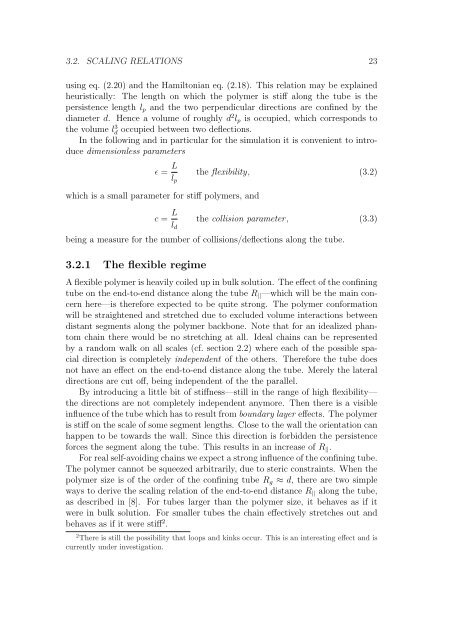Polymers in Confined Geometry.pdf
Polymers in Confined Geometry.pdf
Polymers in Confined Geometry.pdf
You also want an ePaper? Increase the reach of your titles
YUMPU automatically turns print PDFs into web optimized ePapers that Google loves.
3.2. SCALING RELATIONS 23<br />
us<strong>in</strong>g eq. (2.20) and the Hamiltonian eq. (2.18). This relation may be expla<strong>in</strong>ed<br />
heuristically: The length on which the polymer is stiff along the tube is the<br />
persistence length lp and the two perpendicular directions are conf<strong>in</strong>ed by the<br />
diameter d. Hence a volume of roughly d2lp is occupied, which corresponds to<br />
the volume l 3 d<br />
occupied between two deflections.<br />
In the follow<strong>in</strong>g and <strong>in</strong> particular for the simulation it is convenient to <strong>in</strong>troduce<br />
dimensionless parameters<br />
ɛ = L<br />
which is a small parameter for stiff polymers, and<br />
lp<br />
c = L<br />
ld<br />
the flexibility, (3.2)<br />
the collision parameter, (3.3)<br />
be<strong>in</strong>g a measure for the number of collisions/deflections along the tube.<br />
3.2.1 The flexible regime<br />
A flexible polymer is heavily coiled up <strong>in</strong> bulk solution. The effect of the conf<strong>in</strong><strong>in</strong>g<br />
tube on the end-to-end distance along the tube R||—which will be the ma<strong>in</strong> concern<br />
here—is therefore expected to be quite strong. The polymer conformation<br />
will be straightened and stretched due to excluded volume <strong>in</strong>teractions between<br />
distant segments along the polymer backbone. Note that for an idealized phantom<br />
cha<strong>in</strong> there would be no stretch<strong>in</strong>g at all. Ideal cha<strong>in</strong>s can be represented<br />
by a random walk on all scales (cf. section 2.2) where each of the possible spacial<br />
direction is completely <strong>in</strong>dependent of the others. Therefore the tube does<br />
not have an effect on the end-to-end distance along the tube. Merely the lateral<br />
directions are cut off, be<strong>in</strong>g <strong>in</strong>dependent of the the parallel.<br />
By <strong>in</strong>troduc<strong>in</strong>g a little bit of stiffness—still <strong>in</strong> the range of high flexibility—<br />
the directions are not completely <strong>in</strong>dependent anymore. Then there is a visible<br />
<strong>in</strong>fluence of the tube which has to result from boundary layer effects. The polymer<br />
is stiff on the scale of some segment lengths. Close to the wall the orientation can<br />
happen to be towards the wall. S<strong>in</strong>ce this direction is forbidden the persistence<br />
forces the segment along the tube. This results <strong>in</strong> an <strong>in</strong>crease of R||.<br />
For real self-avoid<strong>in</strong>g cha<strong>in</strong>s we expect a strong <strong>in</strong>fluence of the conf<strong>in</strong><strong>in</strong>g tube.<br />
The polymer cannot be squeezed arbitrarily, due to steric constra<strong>in</strong>ts. When the<br />
polymer size is of the order of the conf<strong>in</strong><strong>in</strong>g tube Rg ≈ d, there are two simple<br />
ways to derive the scal<strong>in</strong>g relation of the end-to-end distance R|| along the tube,<br />
as described <strong>in</strong> [8]. For tubes larger than the polymer size, it behaves as if it<br />
were <strong>in</strong> bulk solution. For smaller tubes the cha<strong>in</strong> effectively stretches out and<br />
behaves as if it were stiff 2 .<br />
2 There is still the possibility that loops and k<strong>in</strong>ks occur. This is an <strong>in</strong>terest<strong>in</strong>g effect and is<br />
currently under <strong>in</strong>vestigation.













